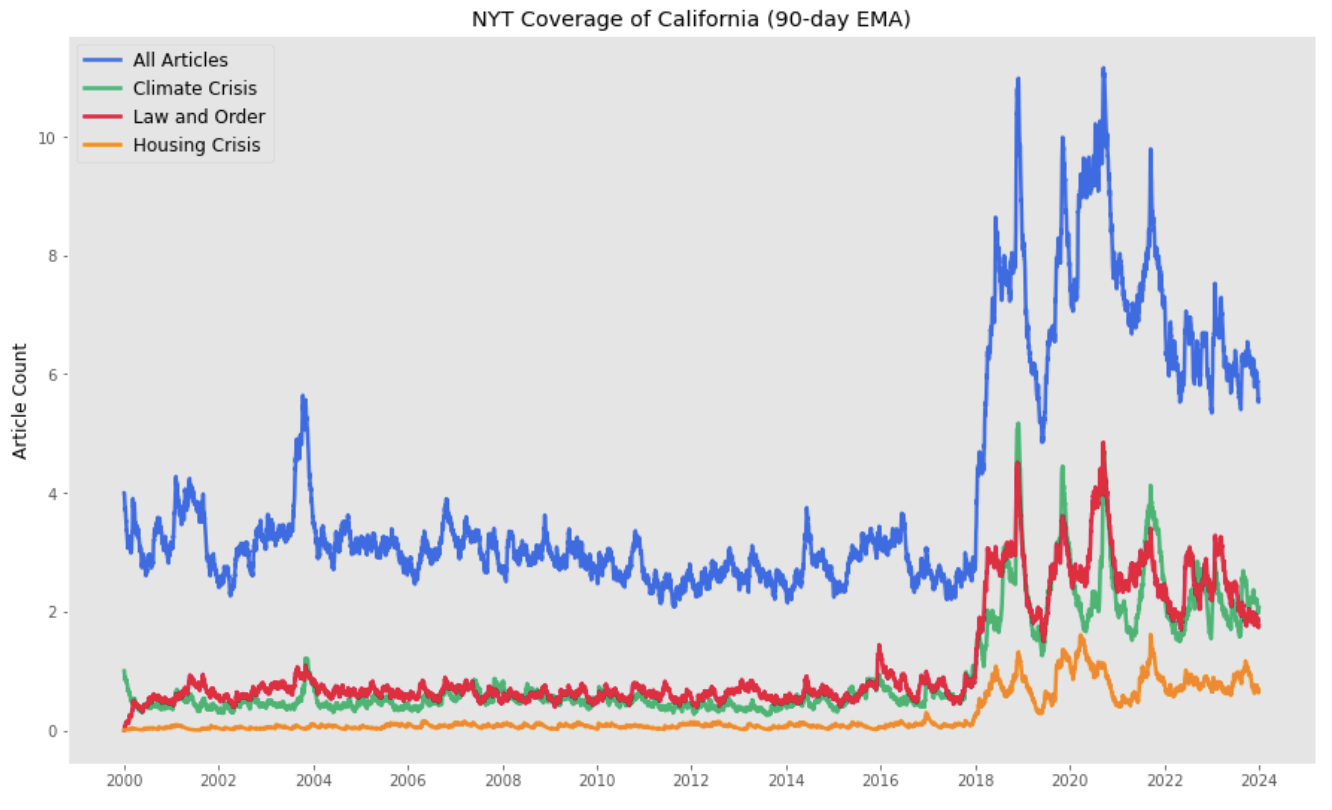Are We Still California Dreamin'?
How the New York Times portrays California

California: the Golden State, a beacon of social resistance, home to sun-kissed shorelines dancing along the Pacific Coast Highway. As a longstanding protagonist in the American dream, the state even garners love letters collected by The New York Times – one reading, “Everyone was happy in California and it all smelled like orange blossoms.” However, California’s legendary reputation has come under threat.
U.S. media skepticism has surged. Coverage highlights disasters that torment the state: drought, fire, homelessness, crime, earthquakes, and population loss. One New York Times piece explains, “California is already in a constant state of bumping up against its boundaries: the dramatic swings between flood and drought […] even Hollywood has lost its luster […]” Crises cast doubt on the state’s once-magnetic allure. For the first time in history, population decline revealed by the 2020 census led to the loss of a congressional seat in the House of Representatives. San Francisco struggles in a “doom loop” as big tech abandons downtown. The state’s homeless population has soared to 181,399 people.
To understand the evolution of the decades-long portrayal of the state by national media, I analyzed all 225,508 articles that mentioned “California” published in The New York Times between January 1, 2000, and December 31, 2023. I then closely examined all 35,204 articles that mentioned California three or more times to isolate those primarily focused on the state. There is no doubt a new wave of crisis rhetoric saturates coverage. What drives this new skepticism of the California dream?
Articles that mentioned California spiked dramatically in 2018. This is largely because of the creation of a new section in The New York Times the previous year, titled “California Today.” An increase in the number of articles does not inherently imply more negative coverage. However, the notable rise is primarily related to stories about climate change, criminal activity, and the housing crisis. The graphic below illustrates this substantial transformation of content.

The New York Times has heavily targeted coverage of the climate crisis – referenced in 33% of all articles since 2018. This topic includes all articles that mention both “California” and climate change, global warming, carbon emissions, drought, flood, earthquake, pollution, heatwave, deforestation, or wildfire. Such articles provoke fear of environmental demise and the future of the state. Columnist Farhad Manjoo presents an example of this when he writes, “Maybe it’s the smoke and the blackouts, but a very un-Californian nihilism has been creeping into my thinking. I’m starting to suspect we’re over. It’s the end of California as we know it.”
Coverage also emphasizes “law and order” – mentioned in 37% of all articles since 2018. This theme encapsulates all articles that include the words conviction, prosecution, jail, prison, police, sheriff, cop, law enforcement, crime, homicide, murder, assault, or shooting. Law and order generates perceptions of insecurity. As New York Times reporter, Soumya Karlamangla, writes, “In California, the pace has felt especially unrelenting. Last week, gunmen killed six people in Tulare County, including a 16-year-old and her 10-month-old child. Then, on Saturday, there was the Monterey Park shooting that killed 11 […]” Governor Gavin Newson was even pulled away from a hospital while meeting victims of the mass shooting in Monterey Park to be briefed about another incident, exclaiming, “Tragedy upon tragedy.” Violence depicts a turbulent reality in California – and the media reveals its full scope and intensity.
Lastly, The New York Times highlights the housing crisis and homeless epidemic in 11% of all articles from 2018 onward. These articles contain the words, unhoused, homeless, houseless, housing cost, housing crisis, or eviction. As The New York Times opinion piece title suggests, “It’s Hard to Have Faith in a State That Can’t Even House Its People.” Climate change, law and order, and the housing crisis invoke fear for the state’s survival. Overall, by emphasizing these challenges in such a large proportion of their stories, The New York Times conveys the impression that California confronts insurmountable issues.
As a result of this portrayal, the overall tone of all articles has also become more negative. Tone is measured by the ratio of positive to negative words within an article. Before 2018, the average tone of articles that mentioned “California” was at times somewhat negative, but equally often decidedly positive. However, after increased coverage of the three themes in 2018, the average tone became purely negative.
The once-glimmering portrayal of California has been replaced by the portrait of a state in turmoil. Since 2018, New York Times coverage has increased dramatically – while largely focusing on the threatening realities of climate change, law and order, and the housing crisis. This transformation challenges the very essence of California’s identity. This new image threatens to reshape public perception into one fueled by fear and uncertainty – weaving an image of a turbulent future. Within this new media landscape, can the Golden State revive the spirit of ‘California Dreamin’ before it’s too late?
–Nikki Sadat
Methodological note: I examined all 225,508 articles containing the root word “California” in The New York Times published between January 1, 2000, and December 31, 2023. I then isolated all 35,204 from the data set that mentioned California three or more times to eliminate articles that are not fundamentally about the state. For additional information regarding our methods, see here. Photo credit: Tom Briskey, Unsplash.